Don’t Miss Out On This Unique Astrological Opportunity
Are you tired of spinning your wheels and getting nowhere? Simply put, you’re out of sync: you’re out of alignment with your astral configuration.
But: there’s a kind of map that can help you reclaim your alignment. Think of it as your own personal blueprint to success and happiness: a blueprint that will help you live your most amazing life.
Get started here.
John 19 is a powerful chapter that takes you through crucial moments leading to the crucifixion of Jesus.
You witness the trial before Pilate, where Jesus faces accusations and is sentenced.
The scene where soldiers mock him by calling him the “King of the Jews” and placing a crown of thorns on his head is intense and gripping.
The journey doesn’t stop there.
As Jesus carries the cross to Golgotha, the place of the skull, you can feel the weight of the moment.
This chapter captures the raw emotions and events leading to the crucifixion.
What’s remarkable is how Jesus’ final words on the cross echo through history, impacting believers then and now.
Witnessing the burial of Jesus, you see followers tenderly placing him in a tomb.
This part of John 19 brings hope mixed with sorrow.
As you explore this chapter, you uncover themes of sacrifice and redemption against the backdrop of Passover, leaving you with important questions and insights.
Key Takeaways
- Jesus is sentenced and mocked as the “King of the Jews.”
- The crucifixion at Golgotha is a pivotal moment in the chapter.
- The burial of Jesus highlights themes of sacrifice and hope.
The Trial and Sentencing of Jesus
In John 19, Jesus faces trial before Pontius Pilate.
The Roman governor struggles with the decision under pressure from both the Jewish leaders and the crowd.
This section focuses on key events and elements of this historic trial.
Pontius Pilate’s Decision
Pontius Pilate played a critical role in the trial of Jesus.
When Jesus was brought to Pilate, he was pressured to judge Him.
Pilate had Jesus flogged and crowned with thorns, mocking Him as “King of the Jews.”
Despite this, Pilate didn’t see a reason for a death sentence and initially sought to release Jesus.
Yet, the pressure increased as the crowd threatened Pilate’s loyalty to Caesar, claiming that releasing Jesus would show disloyalty to the emperor.
Pilate, fearful of losing his position, ultimately handed Jesus over to be crucified.
He washed his hands, symbolizing his attempt to push the responsibility away.
Jewish Leaders and the Crowd
The Jewish leaders and the crowd were fundamental in the events.
They brought Jesus to Pilate, accusing Him of claiming to be the “King of the Jews.” This, they argued, was a challenge to Caesar’s authority, driving Pilate into a corner.
The crowd shouted “Crucify!” demanding Jesus’s death despite Pilate’s reluctance.
The leaders insisted that their law required Jesus to die since He claimed to be the Son of God.
Afraid of political repercussions, Pilate gave in.
The chief priests rejected any king but Caesar, showing their willingness to compromise religious beliefs for their political aims.
Ultimately, this pressure led to the sentencing of Jesus.
The Crucifixion at Golgotha
At Golgotha, the story of the crucifixion unfolds.
Witness how Jesus carried the cross to this place, and learn about the events that marked his final moments.
Jesus Bears the Cross
As you picture this scene, Jesus is tasked with carrying his own cross.
The path leads to Golgotha, meaning “Place of the Skull.” It’s a rough journey surrounded by a mix of onlookers, bewildered supporters, and Roman soldiers.
Soldiers oversee this cruel procession.
The crowd chants, “Crucify Him!” In the face of adversity, Jesus moves forward.
He carries the burden symbolizing his role as the “King of the Jews.”
This moment is a significant point in the account, emphasizing Jesus’ strong spirit and mission.
It echoes the fulfillment of the scriptures and his endurance under harsh conditions.
Despite the suffering he faced, his determination never wavered, showing his deep commitment to his purpose.
Many who witnessed these events may have wondered, how old was Jesus at this crucial time, as his wisdom and strength seemed beyond his years.
His actions and words during these moments continue to inspire faith and reflection.
The Execution
Arriving at Golgotha, the execution proceeds.
Jesus is crucified among two others.
The inscription “King of the Jews” is placed over him, highlighting the irony of a king crowned with thorns.
Here, watch as soldiers divide his clothes and offer him vinegar on a hyssop branch when he is thirsty.
These acts align with scriptural predictions.
Finally, you reach the poignant moment where Jesus declares, “It is finished.” Blood and water flow as a soldier pierces his side.
The scene captures the gravity of his sacrifice, marking the profound death of Jesus and leaving a lasting impression on history and faith.
The Burial of Jesus Christ

The burial of Jesus was an important event involving key figures like Joseph of Arimathea and Nicodemus.
They ensured that Jesus’ body was treated respectfully according to Jewish burial customs.
Joseph of Arimathea’s Role
Joseph of Arimathea was a secret disciple of Jesus.
He asked Pilate for Jesus’ body after the crucifixion.
This was a brave move since he feared the Jewish leaders.
Joseph wanted to ensure that Jesus received a proper burial according to Jewish customs.
Joseph used his own tomb, likely a rock-hewn cave, as the burial place.
He wrapped Jesus’ body in linen.
This was a common practice to prepare for burial.
Taking utmost care of Jesus’ body showed Joseph’s loyalty and devotion.
Despite the fear, his actions demonstrated deep respect and faith in Jesus.
Nicodemus and the Burial Spices
Nicodemus, another follower of Jesus, joined Joseph in preparing Jesus’ body for burial.
He brought a mixture of myrrh and aloes.
This mixture was about 75 pounds, a large amount showing honor and love.
Spices like myrrh and aloes were traditional in the burial process to preserve the body and mask any odors.
Nicodemus helped wrap the body in strips of linen with the spices.
The burial took place in a garden near the crucifixion site, called Golgotha.
With the approaching Sabbath, they worked quickly to ensure the burial was complete before sunset.
Nicodemus’ contribution revealed his commitment to Jesus’ memory and his significant role in these final moments.
Frequently Asked Questions

In John 19, the trial and crucifixion of Jesus are described with important theological insights.
This chapter includes powerful statements, each carrying deep meaning and historical significance.
What is the significance of ‘It is finished’ as mentioned in John 19?
When Jesus says, “It is finished,” He declares the completion of His mission to save humanity.
This moment signifies the end of His suffering and the fulfillment of prophecies about the Messiah.
It marks the climax of His purpose on Earth, offering salvation through His sacrifice.
Could you explain the context of John 19:11?
In John 19:11, Jesus speaks to Pilate about authority.
He highlights that Pilate’s power comes from above, indicating divine oversight.
This statement emphasizes God’s ultimate control even in situations of injustice, as seen through Pilate’s reluctant role in Jesus’ crucifixion.
What does John 19:7 refer to?
John 19:7 refers to the Jewish leaders’ charge against Jesus.
They claim He deserves death because He declared Himself the Son of God, which they consider blasphemy.
This accusation underscores why the religious leaders were insistent on His crucifixion, despite Pilate’s hesitations.
Can you describe the events outlined in John 19:16?
In John 19:16, Pilate concedes to the crowd’s demands, handing Jesus over for crucifixion.
This decision follows a tense interaction with the crowd and religious authorities.
Pilate’s action marks the beginning of the end of Jesus’ earthly journey as He is led away to be crucified.
How is John 19 interpreted in different Bible versions like KJV, ESV, NIV, and NLT?
Bible versions such as the KJV, ESV, NIV, and NLT present John 19 with slight differences in language but maintain the core events and themes.
These variations may affect readability and interpretation slightly, yet each version strives to convey the chapter’s profound impact and message.
What insights do commentaries like ‘Enduring Word’ offer on John chapter 19?
Commentaries like ‘Enduring Word’ delve into the detailed analysis of John 19.
They provide historical, cultural, and theological insights that aid in a deeper comprehension of the text.
These resources often explore the meanings behind Jesus’ words and the actions of those involved.



